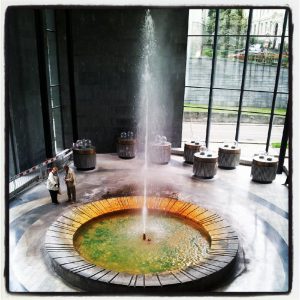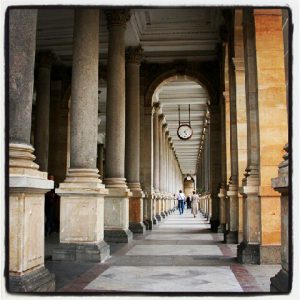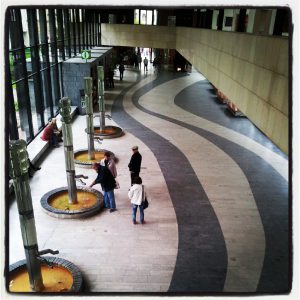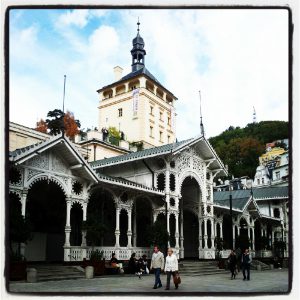The springs of Karlovy Vary (Karlsbad/Carlsbad)
By Tracy A. Burns
 Named after Holy Roman Emperor and Bohemian King Charles IV, the west Bohemia spa town of Karlovy Vary is renowned for its hot, curative springs. Patients flock to the spa town to stroll along the richly decorated colonnades and to take advantage of the healing waters of the 13 main springs and smaller springs, of which there are around 300.
Named after Holy Roman Emperor and Bohemian King Charles IV, the west Bohemia spa town of Karlovy Vary is renowned for its hot, curative springs. Patients flock to the spa town to stroll along the richly decorated colonnades and to take advantage of the healing waters of the 13 main springs and smaller springs, of which there are around 300.
The history of the springs
For centuries a debate has ensued about whether it is better to bathe in the waters or to drink them. In the Middle Ages patients bathed in the therapeutic waters for as many as 12 hours per day. The water was not considered drinkable for fear that the sediment would upset the digestive system. During the late 15th century and early 16th centuries, Dr. Vaclav Payer asserted that patients could both drink and bathe in the waters. By the 17th century, it was believed that the waters were drinkable. In the middle of the 18th century, patients were forced to drink up to 70 cups of water daily. During the 18th century, Dr. David Becher promoted drinkable cures. After he encouraged patients to take long walks, the colonnades were built. Today there are five colonnades housing the springs – The Mill Colonnade, The Hot Spring Colonnade, The Park Colonnade, The Castle (or Chateau) Colonnade, and the Market Colonnade. The springs help cure diseases such as obesity, diabetes, gout, gastrointestinal disorders, metabolic disorders, neurological disorders, and locomotor system disorders.
 The springs at the Mill Colonnade
The springs at the Mill Colonnade
The Mill Colonnade is the largest and most popular of the five, built-in pseudo-Renaissance style. It features five springs – the Mill Spring, the Rock Spring, the Libuse Spring, the Rusalka or Nymph Spring, and the Prince Wenceslas Spring. Taking its name from an old mill that used to be located nearby, the Mill Spring (56° C) dates back to the 16th century and in past centuries was used for bathing. It even used to be possible to buy this thermal water in Czech pharmacies. The Rock Spring (53° C) originally was located next to the Tepla River but now is situated at the Mill Colonnade. Originally dubbed the Spring of Elizabeth’s Roses, the Libuse Spring (62° C) is situated where four springs come together. It was born when it burst out of a cellar during the construction of the Mill Colonnade. This spring is 17.5 meters deep. The Rusalka or Nymph Spring (60° C), formerly the New Spring, used to have its own colonnade, but today can be accessed from the Mill Colonnade. Carlsbad salt used to be produced from the waters of the Prince Wenceslas I Spring (65° C), which has a second stream called the Prince Wenceslas II Spring (58° C).
 The Hot Spring
The Hot Spring
The Hot Spring Colonnade made of glass and reinforced concrete in functionalist style houses the largest and hottest spring. The Hot Spring, called Vridlo in Czech (72° C), belches out 2,000 liters of thermal water per minute, rising to a height of 12 meters. It is the only spring used for bathing and is also drinkable. Five additional seeps near the famous site include drinkable streams dubbed A, B, and C at 72° C, 57° C and 41° C. The Hot Spring is the location of a famous legend about the founding of Karlovy Vary back in the 14th century. The legend claims that a hunting troop of Emperor Charles IV came upon this spring when a hunting dog was burned by its waters. Then Emperor Charles IV established Karlovy Vary. In reality, though, people have gathered at the curative waters as far back as the 13th century.
The springs at the Park Colonnade
The wrought-iron Park Colonnade set in Dvorak Park features elaborate decoration and was once part of the Blanensky Pavilion concert and restaurant hall. During its reconstruction from 2000 to 2002, the Snake Spring (30° C) was placed there. Though it contains fewer minerals than other springs, the Snake Spring boasts more carbon dioxide. The Park Spring (47.4° C) has been reachable from the nearby underground area of the Military Spa Institution since the 19th century. The Freedom Spring (62.4° C), hailing from the 19th century, has been referred to in the past as the Spa Spring and Emperor Franz Joseph I Spring.
The Castle Spring
The Castle Spring, located in the Castle (Chateau) Colonnade, consists of two streams – the Lower Castle Spring (55° C) and the Upper Castle Spring (50° C). They hail from 1769. The Lower Castle Spring has a depth of 28 C. When the Hot Spring burst out in 1809, Castle Spring disappeared. It finally returned to the spot after a 14-year absence. In 1913 the Lower Castle Spring was decorated with a sandstone Art Nouveau relief featuring the ghost of the springs. While the Upper Castle Spring is open to the public, the Lower Castle Spring is only available to guests of the Castle Spa.
The springs at the Market Colonnade
 The Market Colonnade, an exquisite, white 1883 structure boasting delicate motifs of lace on its facade, hosts the drinkable Market Spring (62° C), hailing from 1838. The Charles IV Spring (64° C) is also situated there. It gets its name from a legend claiming that Emperor Charles IV bathed his feet this spring and was inspired by its waters to establish a spa on the premises. This spring there is a relief depicting the founding of the town.
The Market Colonnade, an exquisite, white 1883 structure boasting delicate motifs of lace on its facade, hosts the drinkable Market Spring (62° C), hailing from 1838. The Charles IV Spring (64° C) is also situated there. It gets its name from a legend claiming that Emperor Charles IV bathed his feet this spring and was inspired by its waters to establish a spa on the premises. This spring there is a relief depicting the founding of the town.
The 14th spring
The Alois Klein’s Arbor, which has a distinctly Swiss appearance, is a wooden structure in an octagonal shape made in 1997. Located in the southern part of town, it is situated in the park in front of the Parkhotel Richmond. The arbor houses Karlovy Vary’s 14th spring, the Stepanka Spring (13° C), which boasts drinkable water. This spring is also one of the coldest in the town. It has existed since 1884 but disappeared in the early 20th century. It did not make another appearance until 1993. Its waters have not been officially declared as having healing powers.



